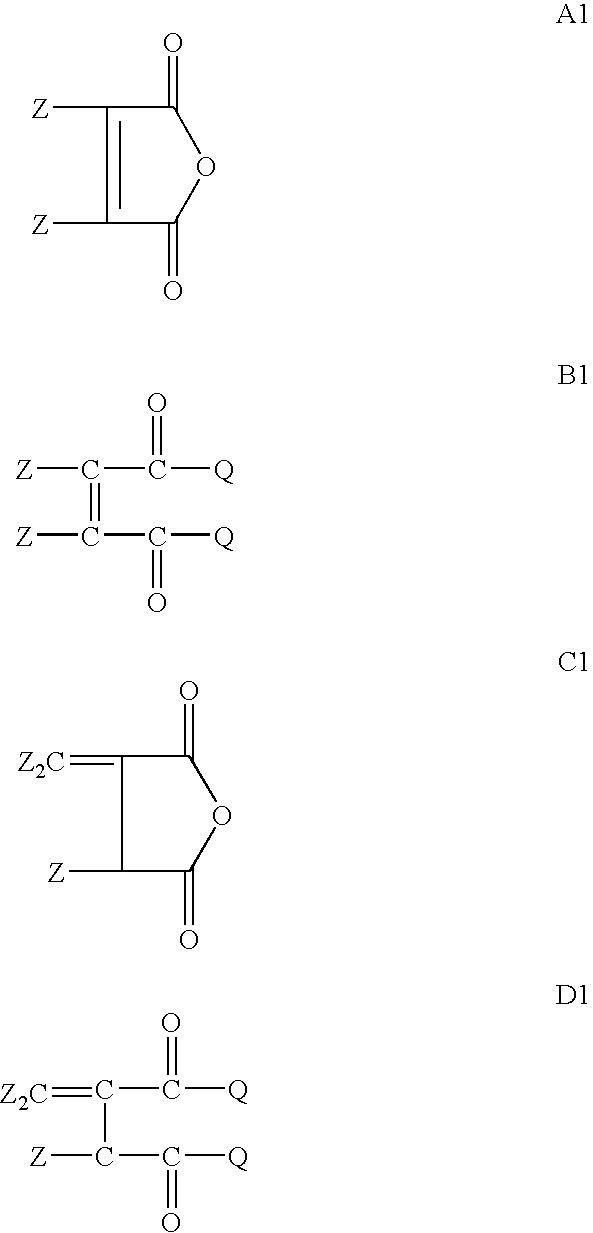Alkyl acrylate copolymer vi modifiers and uses thereof
- Summary
- Abstract
- Description
- Claims
- Application Information
AI Technical Summary
Benefits of technology
Problems solved by technology
Method used
Image
Examples
examples
[0088] Acylated alkyl methacrylate copolymers were initially prepared in the following manner. Butyl methacrylate (“BMA”, MW=142.2), lauryl methacrylate (“LMA”, MW=262.2), and cetyl methacrylate (“CMA”, MW=327.6), were combined with maleic anhydride (“MA”, MW=98.06), lauryl mercaptan (“LSH”) and process oil were charged to a two liter reaction vessel equipped with nitrogen atmosphere and two mixing impellers rotated at 300 rpm during the reaction. The reaction mixture is preheated to about 85° C. and then azoisobutyronitrile (ABN) is added. The reaction was allowed to proceed for about 4 hours at about 79-85° C. followed by 1 hr at about 100° C. In some cases additional oil may be added at this stage to make the product pour easily. Unreacted maleic anhydride and free radical initiator were removed by heating the reaction mass to about 120° C., and applying a vacuum. The weight ratios of the reactant during polymerization and the molecular weights of the resulting acylated copolymer...
example 7
[0090] The acylated alkyl methacrylate copolymer of Example 5 was mixed with process oil at a temperature of 135° C. with mechanical stirring while the mixture was maintained under a nitrogen blanket. After the copolymer was dissolved, a mixture of n-phenyl-p-phenylenediamine (“NPPDA”, MW=184.0) and ethoxylated lauryl alcohol (“ELA,” SURFONIC® L24-2, Huntsman Chemical Company) were added and the resulting reaction mixture was maintained at between 160 to 170° C. under a nitrogen atmosphere with mechanical stirring for about 3 hrs. The resulting reaction mixture containing the multifunctionalized polymer reaction product was filtered. % N=0.36.
example 8
[0091] 310g of the acylated alkyl methacrylate copolymer of Example 3 was mixed with 77.4 g of process oil at a temperature of 140° C. with mechanical stirring while the mixture was maintained under a nitrogen blanket. After the copolymer was dissolved, a mixture of 17.05 g of n-phenyl-p-phenylenediamine (“NPPDA”, MW=184.0) and 8.54 g of ethoxylated lauryl alcohol (“ELA,” SURFONIC®V L24-2, Huntsman Chemical Company) were added and the resulting reaction mixture was maintained at between 140° C. under a nitrogen atmosphere with mechanical stirring for about 6 hrs. The resulting reaction mixture was then vacuum stripped. % N=0.65
PUM
| Property | Measurement | Unit |
|---|---|---|
| Percent by mass | aaaaa | aaaaa |
| Percent by mass | aaaaa | aaaaa |
| Percent by mass | aaaaa | aaaaa |
Abstract
Description
Claims
Application Information
 Login to View More
Login to View More - R&D
- Intellectual Property
- Life Sciences
- Materials
- Tech Scout
- Unparalleled Data Quality
- Higher Quality Content
- 60% Fewer Hallucinations
Browse by: Latest US Patents, China's latest patents, Technical Efficacy Thesaurus, Application Domain, Technology Topic, Popular Technical Reports.
© 2025 PatSnap. All rights reserved.Legal|Privacy policy|Modern Slavery Act Transparency Statement|Sitemap|About US| Contact US: help@patsnap.com



